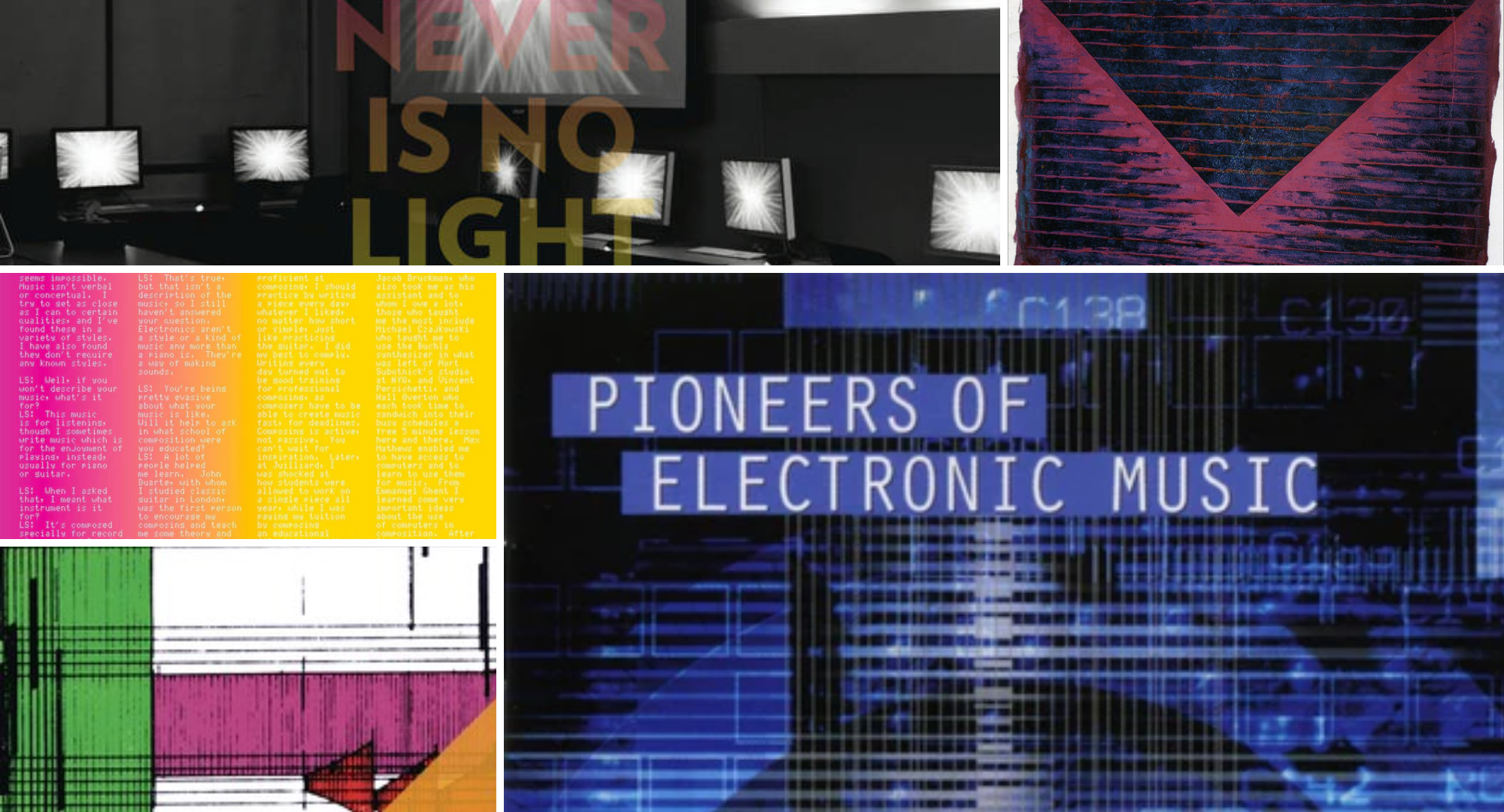For my 100 Days of Summer Listening project, I created 10 group names to give the project some structure and help me select albums. They’ve turned out to be fun listening guideposts so I’m going to use them as playlist themes here and there.
The full list of “Listening Lists”:
- Bang on a Can
- Concertos (none of which overlapped with last week’s playlist!)
- Difficult Listening Hour
- Mouth Sounds
- Electronic Elders
- John Adamses
- OG Ambient
- Something Old
- String Quartets of Ben Johnston
- Pandemic Projects
I know some of you are listening along, so I will try not to be duplicative! This week’s playlist focuses on experimental / avant garde electronic music created primarily from the 60s to 90s. In looking at early electronic music, specifically in America, there is a glaring paleness to the composers. If anyone has books on BIPOC folks in early computer or electronic music, or composers I should learn about – please let me know! Heads up, Sibelius in His Radio Corner, has extremely high pitches- if you are sensitive to that, I suggest skipping this work.
To make sure these playlists delivered to your inbox every week, sign up for my newsletter.
I give this playlist a Difficult Listening Hour rating of 8/10.
The Unquestioned Answer by Laurie Spiegel. Album: The Expanding Universe.
From the Unseen Worlds label website, “The Expanding Universe is the 1980 debut album by composer and computer music pioneer Laurie Spiegel. … The pieces comprising The Expanding Universe combine slowly evolving textures with the emotional richness of intricate counterpoint, harmony, and complex rhythms (John Fahey and J. S. Bach are both cited as major influences in the original cover’s notes), all built of electronic sounds. These works, often grouped with those of Terry Riley, Phil Glass, Steve Reich, differ in their much shorter, clear forms. Composed and realized between 1974 and 1977 on the GROOVE system developed by Max Mathews and F.R. Moore at Bell Laboratories, the pieces on this album were far ahead of their time both in musical content and in how they were made”
Guy’s Harp by Paul Lansky. Album: Smalltalk
From the liner notes, “While Smalltalk and Late August are highly quantized musical photographs of casual conversation, Guy’s Harp and Not So Heavy Metal are images of familiar kinds of music. Guy’s Harp is a kind of documentary about Guy DeRosa playing blues harmonica. The harmonica is abstracted from its normal associations and placed in a context where the entire universe is culled from harmonica sounds: big harmonicas, small harmonicas, clouds of harmonicas, a double bass harmonica and even a meta-harmonica in which the resonance of a space is tuned to the teeth of his harmonica. Guy’s improvisations seed all these passages and form their foundation.”
Century C by Pauline Anna Strom. Album: Trans-Millenia Consort.
From the liner notes, “Trans-Millenia Consort is the near mythical debut album by the late West Coast composer, healer, and medium Pauline Anna Strom. First released in 1982, the album is a bold and beautiful evocation of a life that exists between and beyond time. Evoking ancient rituals and primordial futures, the music of Trans-Millenia Consort glows with a strange iridescence; its pulsing embryonic waveforms flutter and drift, tones fall like raindrops of the long-ago, and melodies shimmer and dance across the ages like fireflies of a lost world.”
Sibelius in His Radio Corner by Ingram Marshall. Album: Ingram Marshall: IKON and Other Early Works.
About the composer, from his web bio, “Ingram Marshall […] lived and worked in the San Francisco Bay Area from 1973 to 1985 and in Washington Sate, where he taught at Evergreen State College, until 1989. He studied at Lake Forest College, Columbia University and California Institute of the Arts, where he received an M.F.A., and has been a student of Indonesian gamelan music, the influence of which may be heard in the slowed-down sense of time and use of melodic repetition found in many of his pieces. In the mid-seventies he developed a series of “live electronic” pieces such as Fragility Cycles, Gradual Requiem, and Alcatraz in which he blended tape collages, extended vocal techniques, Indonesian flutes, and keyboards. He performed widely in the United States with these works. In recent years he has concentrated on music combining tape and electronic processing with ensemble and soloists.”
Rocky Mountains by Wendy Carlos. Album: The Shining, Selections from the Original Motion Picture Soundtrack.
Wendy Carlos has full control over her works, minus a few movie scores. She does not have her catalogue on streaming platforms – so if you see physical media with her work on it in the wild – BUY IT.
Gargoyles by Otto Luening. Album: Columbia-Princeton Electronic Music Center, Prophets of the New.
From the New York Library’s Archives & Manuscripts site, “Otto Luening was an American composer, teacher, conductor, and flautist, and was a pioneer in the field of electronic music. … Along with Vladimir Ussachevsky, he established an electronic music center at Columbia University (which was later named the Columbia-Princeton Electronic Music Center). … In addition Luening was a co-founder of ACA i.e. American Composers Alliance and the American Music Center (1939).”
New York Social Life by Laurie Anderson. Album: New Music for Electronic and Recorded Media: Women In Electronic Music – 1977.
About the composer, from her bio, “Laurie Anderson is one of America’s most renowned – and daring – creative pioneers. Known primarily for her multimedia presentations, she has cast herself in roles as varied as visual artist, composer, poet, photographer, filmmaker, electronics whiz, vocalist, and instrumentalist.”
Concerto for Computer and Orchestra by John Melby performed by the Polish National Radio Symphony Orchestra. Album: Melby, J.: Concerto for Computer and Orchestra / Concerto for Violin, Piano and Computer / Concerto No. 2 for Piano and Computer
Notes from publisher Carl Fischer, “Concerto for Computer and Orchestra was composed in 1987, and is dedicated to the memory of three of the composer’s Philadelphia friends: Harold Feldman, and Vincent and Dorothea Persichetti. The title of the work reflects the fact that the soloist in this concerto is the tape, and also that the orchestra assumes its traditional role in a concerto. This does not mean that the orchestra is always an accompaniment to the tape, at times it assumes an equal status and at times it is of primary importance. However, the basic primacy of the tape is emphasized by the fact that the tape has extended cadenza.”
Poème Electronique by Edgar Varèse. Album: The Varèse Album.
From a bio provided by the LA Phil, “EDGARD VARÈSE, whom many refer to as the father of electronic music, was born in 1883 in Paris, France. … In 1907, Varèse left Paris for Berlin and developed a close friendship with Ferruccio Busoni. … He had an interest in new instruments, particularly electronic ones. It was Debussy that gave the young composer much inspiration, encouraging Varèse to look at non-western music for inspiration. … After serving in the French army during World War I, Varèse moved to Greenwich Village in New York. He fell in love with the sounds of the city and used it as his inspiration.”
Sonic Contours by Vladimir Ussachevsky. Album: Pioneers of Electronic Music.
From the liner notes, “In 1950, the Columbia University Music Department requisitioned a tape recorder to use in teaching and for recording concerts. In 1951, the first tape recorder arrived, an Ampex 400, and Vladimir Ussachevsky, then a junior faculty member, was assigned a job that no one else wanted: the care of the tape recorder. This job was to have important consequences for Ussachevsky and the medium he developed.”
Echoes by Olly Wilson performed by Joshua Rubin. Album: There Never is No Light.
Program note from the composer, “Echoes was commissioned by the clarinetist Phillip Rehfeldt and the composer Barney Childs in 1974 as part of a project to stimulate the composition of contemporary chamber music for “clarinet and friend” (i.e. clarinet and piano, clarinet and electronic tape, etc.). As the titles implies, Echoes is based on a continuous interaction between the clarinet and the electronic sound source which share common pitches, timbres, and musical gestures, while simultaneously developing a larger musical shape. The work contains three organically related sections which gradually evolve from one another in a single continuous movement. …”
The Expanding Universe by Laurie Spiegel. Album: The Expanding Universe.

